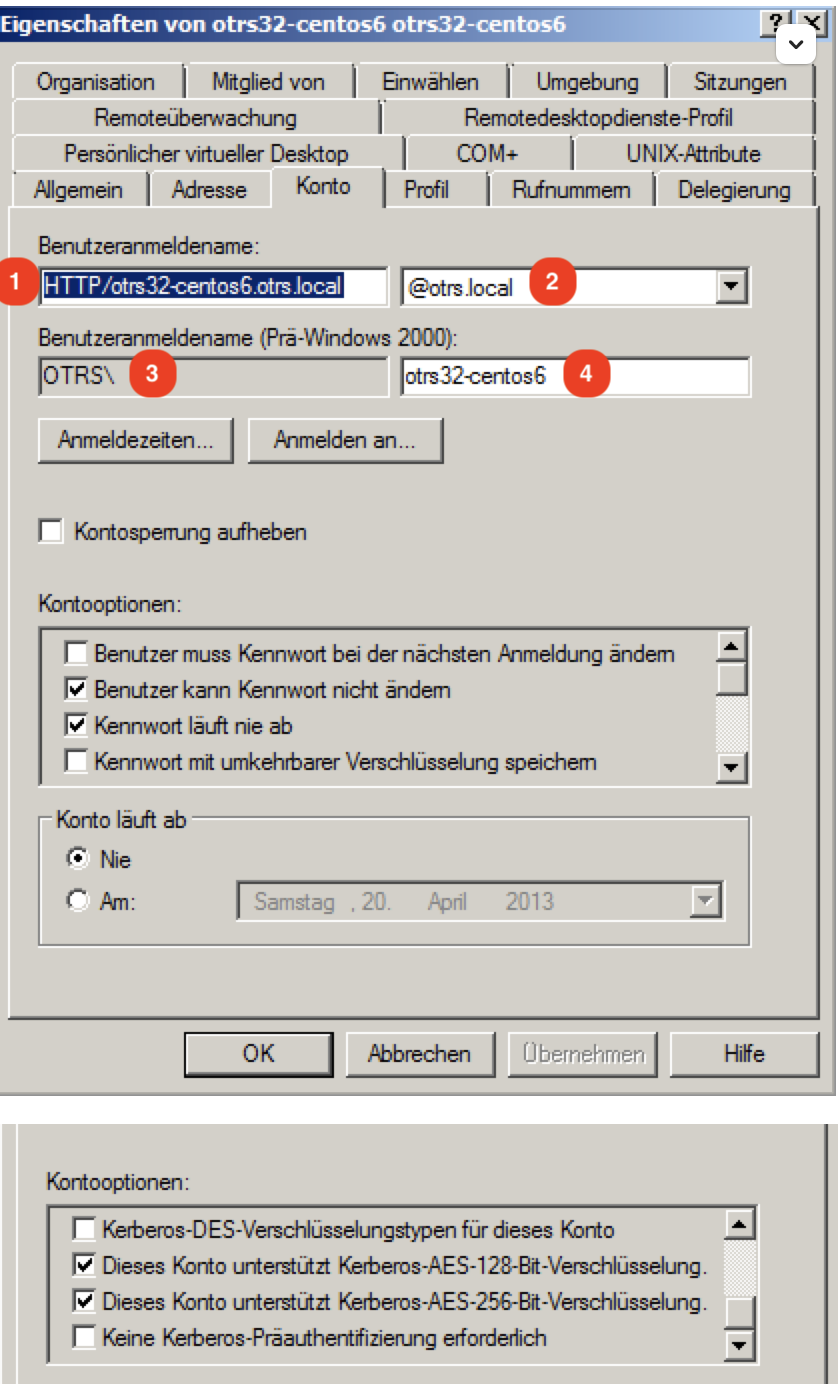Kerberos Single Sign On in der OTOBO Docker-Installation¶
Bitte lesen Sie das Kapitel Installation mit Docker und Docker Compose für grundlegende Informationen über die Installation und Konfiguration von OTOBO. Dieses Tutorial geht davon aus, dass OTOBO mit Docker installiert und konfiguriert wurde.
Bemerkung
Im Folgenden sprechen wir von AD (Active Directory). Natürlich funktioniert die Konfiguration von Kerberos auch mit LDAP.
Active Directory User erstellen¶
Bitte erstellen Sie einen neuen Active Directory Benutzer mit den folgenden Einstellungen und speichern Sie die markierten Einstellungen:
Bemerkung
Bitte verwende als Benutzernamen nur diese Syntax: HTTP/fqdn.from.your.otobo.de. fqdn.from.your.otobo.de muss ein A-Record DNS-Eintrag sein, kein CNAME! Im nächsten Schritt ist es auch möglich, andere URLs für OTOBO zu verwenden, sie müssen dann als CNAME auf unseren oben definierten A-Record zeigen.
Der Benutzername sollte in Großbuchstaben geschrieben sein, da Kerberos ihn auf diese Weise erwartet.
Das Passwort funktioniert nicht zuverlässig mit einigen Sonderzeichen (z.B. ‚&‘).
Sie müssen einen separaten AD-Benutzer anlegen. Sie können nicht jenen benutzen, den Sie bereits für Ihre LDAP/AD-Synchronisation verwenden.

Active Directory Keytab-Datei erstellen¶
Im nächsten Schritt verbinden wir uns mit einem Domain-Controller des Active Directory und öffnen dort eine Konsole (cmd) mit Administratorrechten. Jetzt verwenden wir das Tool ktpass.exe, um die benötigte Keytab-Datei zu generieren:
ktpass.exe -princ HTTP/otrs32-centos6.otrs.local@OTRS.LOCAL -mapuser OTRS\otrs32-centos6 -crypto All -pass Password -ptype KRB5_NT_PRINCIPAL -out c:\krb5.keytab
- -princ = HTTP/otrs32-centos6.otrs.local@OTRS.LOCAL -> Picture Number 1+@+Picture Number 2
- -mapuser = OTRSotrs32-centos6 (Benutzername prä Win 2000) -> -> Bildnummer 3++Bildnummer
- -pass = Passwort vom Benutzer otrs32-centos6 (Active Directory-Benutzer)
- -out = c:/krb5.keytab
Bemerkung
Bitte schreiben Sie die Benutzernamen (@OTRS.LOCAL) immer in Großbuchstaben. Das Passwort darf einige Sonderzeichen nicht enthalten.
Im nächsten Schritt verschieben Sie bitte die Datei krb5.keytab auf den OTOBO-Server:
# Create new directory
docker_admin> mkdir /opt/otobo-docker/nginx-conf
# Move the file krb5.keytab to the new directory (Attention, depending on where you have placed the krb5.conf file, the command below will change.)
docker_admin> mv ?/krb5.keytab /opt/otobo-docker/nginx-conf/krb5.keytab
Erstelle ein neues Volume für deine individuelle nginx-Konfiguration¶
docker volume create otobo_nginx_custom_config
otobo_nginx_custom_config_mp=$(docker volume inspect --format '{{ .Mountpoint }}' otobo_nginx_custom_config)
docker create --name tmp-nginx-container rotheross/otobo-nginx-webproxy:latest-10_1 (achtung: Versionsnummer)
docker cp tmp-nginx-container:/etc/nginx/templates /tmp
docker cp tmp-nginx-container:/etc/nginx/templates/otobo_nginx-kerberos.conf.template.hidden $otobo_nginx_custom_config_mp/otobo_nginx.conf.template
docker rm tmp-nginx-container
vim docker-compose/otobo-nginx-custom-config.yml
COMPOSE_FILE =>
docker-compose/otobo-nginx-custom-config.yml
NGINX_ENVSUBST_TEMPLATE_DIR=/etc/nginx/config/template-custom
Neue OTOBO .env*-Datei anlegen¶
Zunächst müssen wir die alten Datei /opt/otobo-docker/.env in .env.tmp umbenennen und erstellen dann eine neue Datei .env , die die Kerberos-Einstellungen beinhaltet.
# Stop OTOBO Container if running
docker_admin>cd /opt/otobo-docker
docker_admin>docker-compose down
# create a backup of the old .env file
docker_admin>mv /opt/otobo-docker/.env /opt/otobo-docker/.env.tmp
# create a new backupfile including kerberos settings
docker_admin>cp /opt/otobo-docker/.docker_compose_env_https_kerberos /opt/otobo-docker/.env
Kopiere jetzt deine bestehenden Konfigurationsoptionen in die neue .env-Datei (mindestens OTOBO_DB_ROOT_PASSWORD, OTOBO_NGINX_SSL_CERTIFICATE, OTOBO_NGINX_SSL_CERTIFICATE_KEY) und füge die folgenden Kerberos-Einstellungen hinzu:
# Kerberos keytab OTOBO_NGINX_KERBEROS_KEYTAB=/opt/otobo-docker/nginx-conf/krb5.keytab
# Kerberos-Konfig (Wichtig, bitte kommentiere diese Option wie hier aus!) # In der Standardkonfiguration wird die krb5.conf-Datei automatisch generiert # OTOBO_NGINX_KERBEROS_CONFIG=/opt/otobo-docker/nginx-conf/krb5.conf
# Kerberos Service Name OTOBO_NGINX_KERBEROS_SERVICE_NAME=HTTP/otrs32-centos6.otrs.local # -> Bild Nummer 1
# Kerberos REALM OTOBO_NGINX_KERBEROS_REALM=ROTHER-OSS.COM -> OTRS.LOCAL # -> Bild Nummer 2
# Active Directory Domain Controller / Kerberos kdc OTOBO_NGINX_KERBEROS_KDC=
# Active Directory Domain Controller / Kerberos Admin Server OTOBO_NGINX_KERBEROS_ADMIN_SERVER=rother-oss.com
# Kerberos Default Domain OTOBO_NGINX_KERBEROS_DEFAULT_DOMAIN=otrs.local
OTOBO starten¶
Nach der initialen Konfiguration von Kerberos starten wir OTOBO erneut:
# Start OTOBO using docker-compose
docker_admin> docker-compose up -d
In OTOBO angeben, dass die Kerberos-Authentifizierung verwendet werden soll¶
Falls du AD-Authentifizierung konfiguriert hast, deaktiviere sie (z.B. durch Auskommentieren der entsprechenden Zeilen in deiner Kernel/Config.pm). Die Authentifizierung wird nicht mehr über LDAP stattfinden.
Um die Kerberos-Authentifizierung zu nutzen, nimm die Kerberos-Zeilen aus Kernel/Config/Defaults.pm und füge sie in deine Kernel/Config.pm ein. Zum Beispiel könnten diese Zeilen funktionieren:
$Self->{AuthModule} = 'Kernel::System::Auth::HTTPBasicAuth';
# In case you need to replace some part of the REMOTE_USER, you can
# use the following RegExp ($1 will be new login).
$Self->{'AuthModule::HTTPBasicAuth::ReplaceRegExp'} = '^(.+?)@.+?$';
Den Browser so konfigurieren, dass er Kerberos SSO versteht¶
Damit SSO funktioniert, muss der Browser entsprechend konfiguriert werden.
Chrome, Edge, Internet Explorer, etc.
Fügen Sie eine Seite unter „Lokale oder vertrauenswürdige Seiten“ hinzu und aktivieren Sie „Integrierte Windows-Authentifizierung“ (Internetoptionen).
Firefox
„about:config“ in die Adresszeile von Firefox eingeben
und folgende Einstellungen anpassen:
- network.negotiate-auth.trusted-uris = https:// (or https://otobofqdn)
- network.negotiate-auth.delegation-uris = http:// (or https://otobofqdn)
Fehlererkennung und Problembehebung¶
Sollte das Kerberos SSO nicht funktionieren, überprüfen Sie bitte zunächst, ob der NGINX-Container gestartet ist:
# Check Container
docker_admin> docker ps
Im nächsten Schritt überprüfen Sie bitte die NGINX-Logs auf mehr Informationen:
# Check NGINX logs
docker_admin> docker logs otobo_nginx_1 -f
Sollte NGINX laufen, loggen Sie sich bitte in den NGINX-Container ein und überprüfen Sie alle benötigten Dateien:
# Login to the NGINX Container
docker_admin> docker exec -it otobo_nginx_1 bash
# Now please check if the krb5.conf file exists with your needed values
nginx_root> cat /etc/krb5.conf
# Now please check if the krb5.keytab file exists
nginx_root> cat /etc/krb5.keytab
# If not, please quit from the container and copy the file again using docker
docker_admin> docker cp /opt/otobo-docker/nginx-conf/krb5.keytab otobo_nginx_1:/etc/krb5.keytab
Kerberos Fehlerbehebung¶
# Login to the NGINX Container
docker_admin> docker exec -it otobo_nginx_1 bash
Nun sind Sie in der Lage, die Kerberos-Einstellungen auf Fehler zu überprüfen. Beispiele:
env KRB5_TRACE=/dev/stdout kvno HTTP/otrs32-centos6.otrs.local@OTRS.LOCAL
klist -e
kinit -VV -k -t /etc/krb5.keytab HTTP/otrs32-centos6.otrs.local@OTRS.LOCAL
Falls Sie auf das Problem stoßen, dass die Authentifizierung scheinbar funktioniert, der Agent aber noch nicht in der Datenbank ist, funktioniert Ihre Synchronisierung (falls implementiert) möglicherweise nicht. Ein Fehler 52e (Erste Bindung fehlgeschlagen) weist darauf hin, dass mit Ihrem Suchbenutzer etwas nicht stimmt. Dies passiert, wenn Sie denselben Benutzer für die AD-Synchronisierung und als SSO-Benutzer verwenden. Bitte verwenden Sie hierfür separate AD-Benutzer. Um nicht eine neue Schlüsseltabelle erstellen und die oben genannten Schritte wiederholen zu müssen, könnte es einfacher sein, einen neuen Benutzer zur Verwendung in Ihrer AD-Synchronisierung zu erstellen (wahrscheinlich in Ihrer Kernel/Config.pm).
Falls SSO nicht richtig funktioniert, stelle sicher: * dass der Benutzer, für den es nicht funktioniert, im Active Directory ist * dass das System in der Domäne ist * dass es ordnungsgemäß als vertrauenswürdige Seite angegeben ist (siehe ‚Browser konfigurieren, um Kerberos SSO zu verstehen‘)